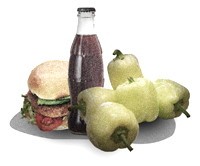Food excess versus food access
Food can be found everywhere you go. Coffee shops, cafeterias and grocery stores line the streets. Gas stations, airports, movie theatres and shopping malls all supply a variety of options to satiate our hunger. But are we really always that hungry? Do we really need that much food?
The Food and Agriculture Organization (FAO) has determined that roughly one billion people on the planet are hungry: that’s about one in six people. However, they have also stated that currently enough food is being produced to provide every single person across the globe with 2,720 calories each day. The average adult typically needs about 2,000 calories each day to maintain weight and supply energy to the body. This means that we should not only be able to feed everyone in the world, but we should also have a surplus of food leftover. Unfortunately, this is not the case.
Our problem is not one of food scarcity; our problem is one of food distribution.
People are suffering from malnutrition due to a lack of access to food as well as the increase in food prices. Political conflicts and economic systems in the developed world also contribute heavily to this severe issue.
It costs money to distribute food. The governments of wealthier countries cannot afford to send food aid without compromising their own economic systems in some way. Moreover, shipping food out to nations in need does nothing to solve the problem at its root: it merely serves as a Band-Aid to hide the symptoms.
The FAO issued a report which shows that 907 million hungry people are situated in Asia, the Pacific and Sub-Saharan Africa, compared with 15 million living in the developed world. The other 95 million people going hungry live in the Near East, North Africa, Latin America and the Caribbean.
The opposite end of the spectrum is equally concerning. The World Health Organization states that chronic obesity, an issue of eating too much food, is a pressing epidemic which can result in disease and death. With over one billion overweight people in the world, most of them living in developed countries, the privileged class are simply eating far more than their share of food.
One in six people are at increased risk of illness and disease because of a lack of food. One in six people are at increased risk of illness and disease because of an overabundance of food. Clearly we need more of a balance to right the scale.
In a world where we value democracy, food distribution is not being appropriately conducted. Malnutrition is associated with poverty, disease and death.
Fairness and equality of rights is neglected in our production and distribution of food. Something that is basic and necessary to our health, well-being and survival has now become a privilege. This is not just.
University of Winnipeg student Sagan Morrow writes a health and wellness blog.
Published in Volume 64, Number 11 of The Uniter (November 12, 2009)







